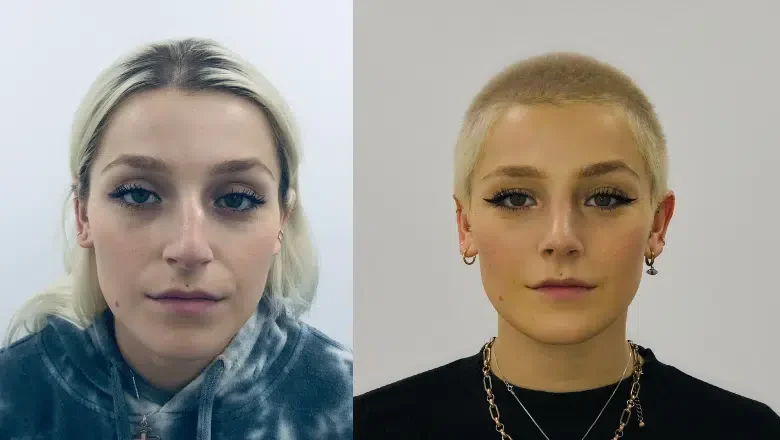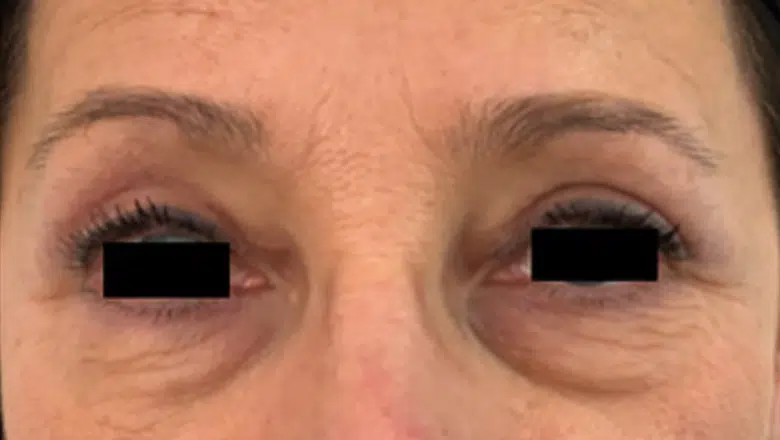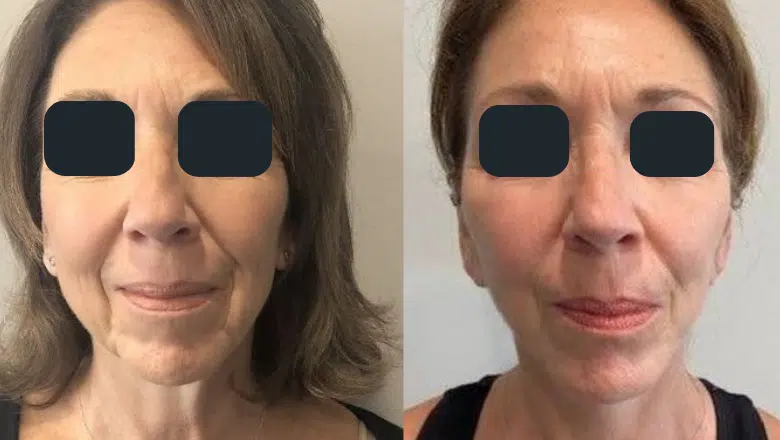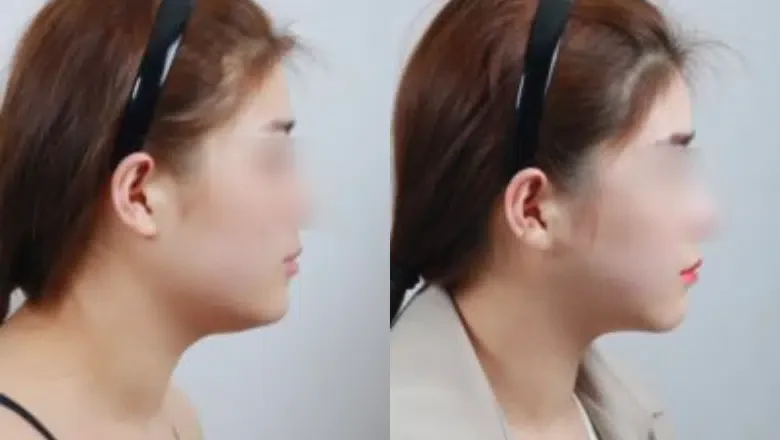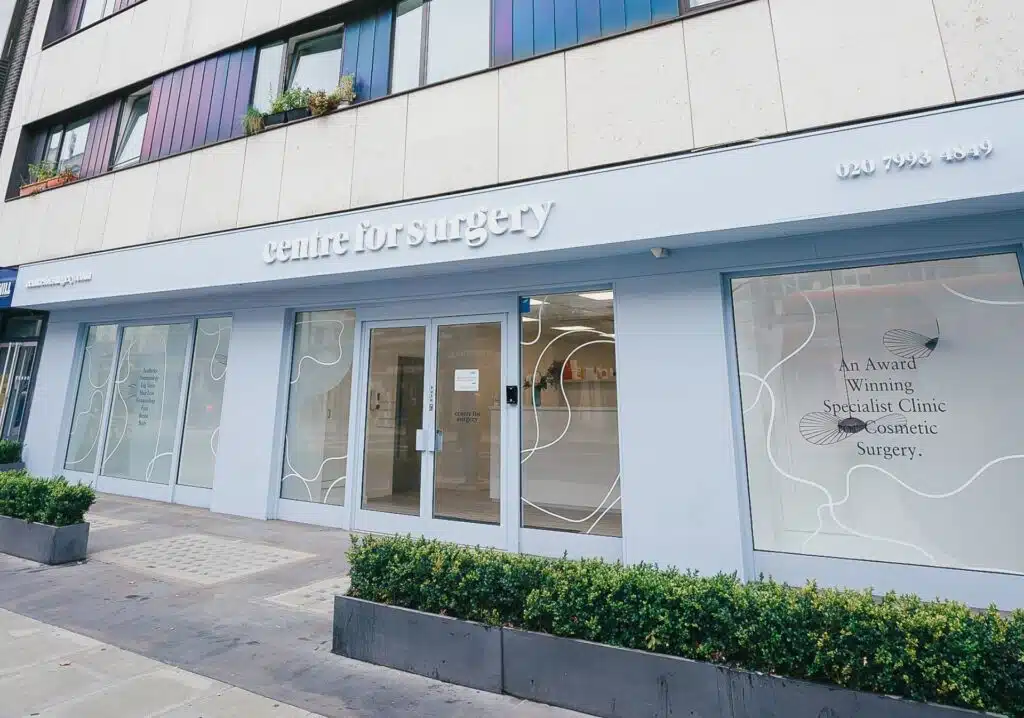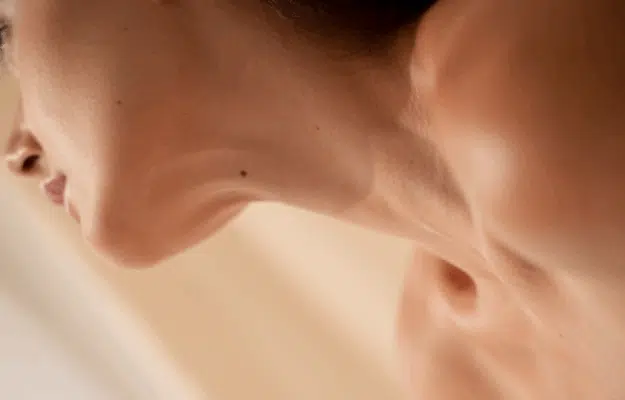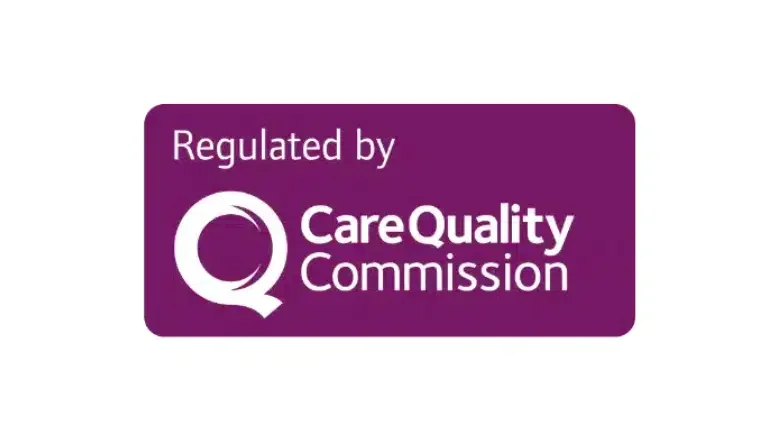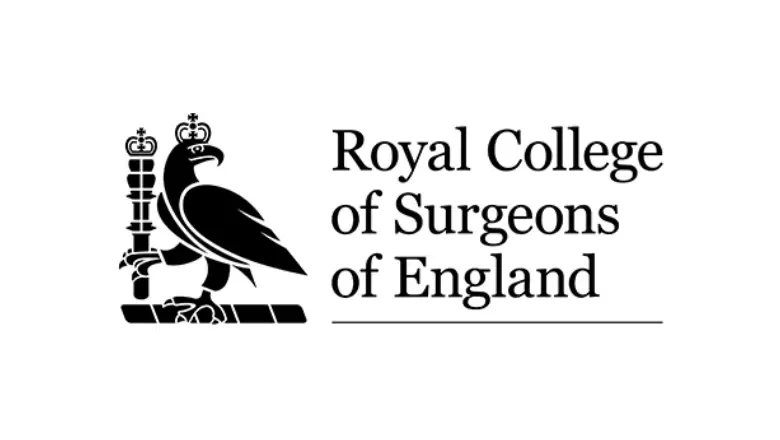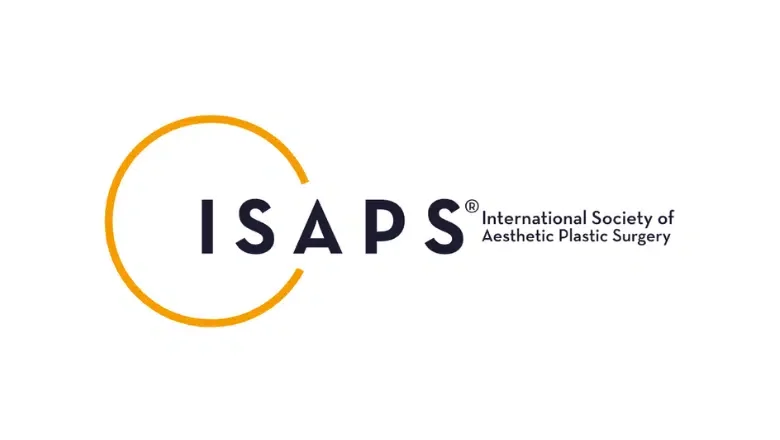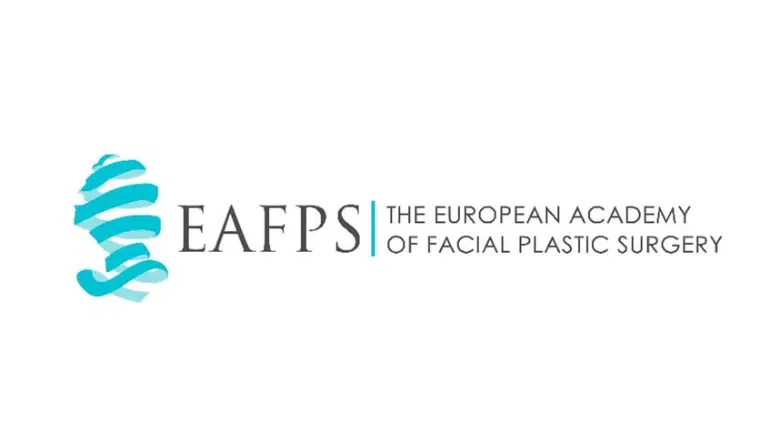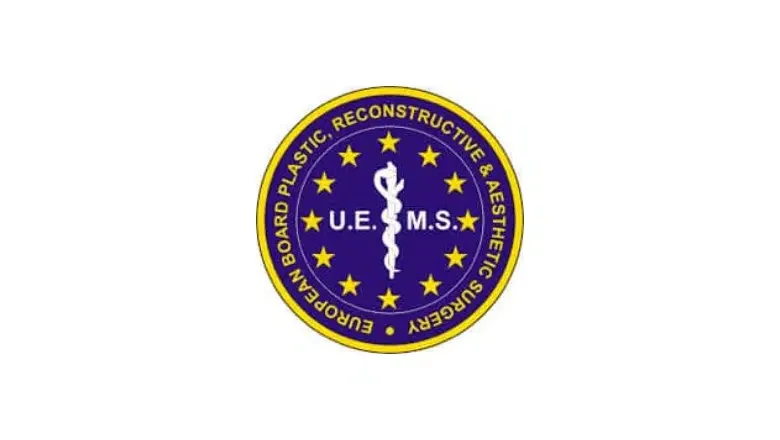Surgical and Non-Surgical Options to Correct a Lopsided or Asymmetric Face
Facial symmetry is a term that we use to describe how much the left and right sides of a person’s face mirror each other. Essentially, it’s a measure of how alike the two halves of a person’s face are when it comes to the size, shape, and positioning of their facial features. When a face is symmetrical, it means that if you were to draw a line down the middle of the face, the two halves would be very similar or nearly identical to each other.
RELATED: Facial Beauty Standards – What is the Golden Ratio?
On the contrary, an asymmetrical face is one where the two sides do not mirror each other exactly. You’d notice some differences between the left and right sides of the face. These could include variations in the size of the eyes, the shape of the cheeks, or the position of the nose, among other things.
Asymmetry in the face can occur for a variety of reasons. Genetics often play a significant role, meaning the traits you’ve inherited from your parents can lead to differences in the symmetry of your facial features. Additionally, an injury to the face could lead to asymmetry, as can the natural process of ageing. As we get older, the skin loses elasticity and can sag or wrinkle, which may contribute to a more asymmetrical appearance.
Many studies over the years have suggested that people are generally more attracted to symmetrical faces. However, it’s crucial to remember that no face is perfectly symmetrical. Each person’s face is unique and individual, and minor asymmetry is perfectly normal and often not something others would even notice. It’s these slight differences and imperfections that give us our individual character and uniqueness. It’s always important to embrace your own individuality and the unique traits that make you, you!
What is an Asymmetrical Face?
An asymmetrical face is a face with features that aren’t perfect mirror images of each other on either side of the face. Your face can look out of balance if one side looks very different from the other side. Facial asymmetry can be attributed to:
- One side of the face has more signs of ageing than the other
- One part of the face is more wrinkled and saggy than the other part
- One eye looks more closed than the other
- One eyebrow is higher than the other
- The nose is crooked toward one side or the other
- One cheek is fuller than the other
- The jaw or chin is uneven or asymmetric
- One ear looks bigger than the other
A certain degree of asymmetry in the face is natural and gives you a unique look. However, you may feel unsatisfied with the way your face looks if your face is too uneven. Our facial plastic surgeons at Centre for Surgery can offer you a range of different alternatives that can make your facial features look more proportional and bring back a beautiful balance to your face.
What Causes Facial Asymmetry?
An asymmetrical face, where features on either side of the face do not match in size, shape or position, can be caused by a multitude of factors. These range from internal genetic factors to external influences, which impact how the face grows, develops and functions.
While it’s entirely normal and usually unnoticeable to have minor facial asymmetry, more pronounced asymmetry can be a cause of self-consciousness and unease for some individuals. Here are a few factors that can contribute to an asymmetrical face:
Genetics
One prevalent cause of facial asymmetry is genetics. It’s not uncommon for some individuals to naturally possess asymmetrical faces due to discrepancies in the development of their facial bones and muscles. For instance, variations in facial bone size and shape or the jaw’s position can lead to facial asymmetry.
Certain genetic conditions can also result in facial asymmetry. These conditions often stem from abnormalities or mutations in genes that govern facial development. Some examples include:
- Craniosynostosis: This condition occurs when the skull bones fuse too early, leading to abnormal growth and development of the head and face.
- Hemifacial microsomia: This condition is characterised by one side of the face being underdeveloped, resulting in visible asymmetry.
- Goldenhar syndrome: This is a rare genetic disorder affecting the face’s development, particularly impacting the eyes, ears, and jaw.
Ageing
Ageing can contribute to facial asymmetry through several mechanisms, such as:
- Changes in bone structure: As we age, our bones lose density and volume.
- Muscle tone changes: Ageing can weaken muscles. Weaker muscles might not support the skin and soft tissue as effectively as before, leading to sagging or drooping on one side of the face.
- Skin elasticity changes: Our skin loses elasticity with age and becomes less resilient to stretching or sagging. This can result in one side of the face appearing more wrinkled or droopy than the other.
To prevent or reduce age-related facial asymmetry, you can:
- Stay hydrated
- Protect your skin from the sun
- Exercise regularly
- Maintain good skincare
Dental Problems
Dental issues can cause facial asymmetry, particularly an asymmetrical jaw. Teeth alignment problems or jaw position can result in noticeable differences between the face’s two sides. For example, a misaligned jaw may make one side of the face look more prominent or recessed than the other.
One prevalent dental issue impacting facial symmetry is teeth misalignment. Misaligned teeth can cause one side of the mouth’s teeth to protrude more than the other, leading to noticeable asymmetry. This also influences the jaw’s position, which can further contribute to jaw asymmetry.
Injury or Trauma
Injury is another common cause of an asymmetrical face. Trauma to the face, such as a broken nose or cheekbone, can change the facial bones’ shape and position, leading to asymmetry. Injuries might result from falls, sports accidents, and car crashes. Fractures, soft tissue injuries, burns, and nerve damage can all affect facial symmetry.
It’s crucial to seek medical help for facial trauma, even if the injury seems minor. A qualified medical professional can assess the injury’s extent and provide the necessary treatment to reduce the risk of complications and encourage healing.
Lifestyle Factors
Lifestyle factors over time can also lead to an asymmetrical face. Factors like poor diet, sleep position, posture, lack of exercise, sun exposure, and smoking can all affect the face.
These factors influence the face’s development and function and the appearance of the face’s skin and muscles, which leads to asymmetry and other ageing signs. To improve facial symmetry and overall health, it’s crucial to make lifestyle changes.
Understanding the Different Kinds of Asymmetrical Faces
When one side of a person’s face looks different in size, shape, or position compared to the other side, we call this condition facial asymmetry. Generally, we can categorise facial asymmetry into two main types: developmental and acquired. Let’s explore these two kinds of facial asymmetry a bit more.
The first type, developmental facial asymmetry, is often present from birth or early childhood. This type of asymmetry may arise due to genetic influences. For instance, it could be linked to inherited traits that determine how our facial features form and develop. However, it’s not always down to our genes. Sometimes, environmental factors can also play a role in causing developmental facial asymmetry. For example, lifestyle habits during pregnancy, such as nutrition or exposure to harmful substances, can potentially affect the symmetry of a baby’s face.
On the other hand, acquired facial asymmetry develops later in life, usually as a result of an injury or a specific medical condition. If you’ve had an accident that resulted in facial injuries, such as a broken nose or a fractured cheekbone, this could cause your face to become asymmetrical. Similarly, certain diseases or health conditions can lead to changes in the symmetry of your face. For instance, conditions like Bell’s palsy, which affects the nerves in the face, or temporomandibular joint disorder, which affects the jaw’s function, can result in an asymmetrical appearance.
Knowing whether facial asymmetry is developmental or acquired is crucial because it helps surgeons make a correct diagnosis and plan the most effective course of treatment. If asymmetry is developmental, the focus may be on cosmetic procedures or therapies to balance the facial features. However, if the asymmetry is acquired, treating the underlying injury or health condition might be the first step, possibly followed by cosmetic procedures to restore facial symmetry. In either case, understanding the root cause is key to addressing the issue in the most appropriate way.
How to Test if You Have a Symmetrical Face
Exploring the symmetry of your face can be both intriguing and insightful, offering a glimpse into how balanced your facial features are. A symmetrical face is often considered a hallmark of beauty, but it’s important to remember that minor asymmetries are common and perfectly normal. If you’re curious about the symmetry of your face, there are straightforward methods you can try at home to assess this.
One basic method involves using a mirror. By positioning yourself directly in front of a mirror, you can observe the alignment of your facial features. Imagine or even use a piece of string to create an imaginary vertical line down the centre of your face. This line serves as a reference point to compare the two halves of your face. Look for any noticeable differences in the size, shape, and alignment of features such as your eyes, ears, nostrils, and the corners of your mouth.
For a more detailed examination, you can conduct a photo test. Start by taking a straight-on photo of your face in a well-lit area to ensure clarity and accuracy. Once you have the photo, print it out on a piece of paper. With the printed photo in hand, use a pen or marker to pinpoint key facial landmarks on both sides of your face, including:
- The peak of your forehead.
- The bottom of your chin.
- The widest part of your nostrils.
- The widest point on your face, typically across the cheekbones.
- The corners where your lips begin.
- The points where your eyes meet your nose bridge.
- The outer creases of your eyes.
Next, use a ruler to draw horizontal lines connecting each set of corresponding points across your face. For example, draw a line from the peak of the forehead on one side to the peak on the other side, and so on for each set of points. This visual representation will help you compare the alignment and distance between similar features on each side of your face, providing a clearer picture of your facial symmetry.
Non-Invasive Options to Address Facial Asymmetry
Exploring the realm of cosmetic enhancement, particularly for those seeking solutions to an asymmetrical face without undergoing surgery, reveals a variety of non-invasive treatments. These treatments have gained popularity due to their ability to improve facial balance and harmony with minimal downtime and risk. Ideal for addressing mild to moderate asymmetries, non-invasive methods can effectively treat discrepancies primarily caused by differences in soft tissue, such as skin laxity or muscle imbalance. While they may not offer the permanent reconfiguration possible with surgical interventions, their ability to temporarily enhance facial symmetry makes them a valuable option for many.
Understanding that the effectiveness of these treatments can vary widely among individuals is crucial. Factors such as the specific nature of the asymmetry, the treatment area, and individual healing responses play a significant role in the outcome. Therefore, it’s essential to have a detailed consultation with a qualified healthcare professional who can assess your unique situation. This professional can offer insights into the most appropriate treatment options based on a comprehensive evaluation of your facial structure and aesthetic goals.
Common Non-Invasive Treatments for Facial Asymmetry
Anti-Ageing Injectables
Anti-wrinkle injections are a popular choice for addressing facial asymmetry related to muscular imbalances. Temporarily paralysing targeted muscles can smooth out uneven facial expressions and reduce the appearance of asymmetry. The procedure is quick, typically taking about 30 minutes, and requires no downtime, allowing patients to resume their daily activities immediately.
Dermal Fillers
Dermal fillers are another effective non-invasive treatment for correcting asymmetrical features. These injectables can add volume and shape to areas that may appear sunken or less defined, such as the cheeks, lips, or under-eye area. Made from hyaluronic acid, a substance naturally found in the body, dermal fillers offer a safe and temporary solution for enhancing facial balance. The treatment session usually lasts no longer than 30 minutes, with results visible almost immediately and no recovery time needed.
Orthodontics
For asymmetries influenced by dental misalignments, orthodontic treatments like braces or clear aligners can provide significant improvements. By correcting the alignment of teeth, these treatments can also impact the overall balance of the face, particularly in profiles and lower facial symmetry. Orthodontic solutions are available for individuals of all ages, and advancements in technology have made these treatments more discreet and comfortable than ever before.
Can Facial Exercises, Hairstyling, and Makeup Help?
Facial Exercises
These exercises can help strengthen the muscles on the weaker or less dominant side of your face, which can help balance out your facial features. Activities such as puckering your lips, raising your eyebrows, or practising different smiles can all contribute to a more symmetrical face.
Massage Therapy
Massaging your face can boost blood circulation, which can help reduce any puffiness and swelling, often seen on one side of the face. Furthermore, it can help relax tense facial muscles, which can contribute to an improvement in facial symmetry.
Strategic Hairstyling
Choosing certain hairstyles can work wonders in balancing out an asymmetrical face. For instance, a side-swept fringe can help downplay a broader forehead, while layers can add volume and movement to balance out an uneven jawline.
Makeup Techniques
Makeup is an incredibly effective tool for creating an illusion of symmetry. Using techniques such as contouring to define your face or highlighting to bring attention to specific features can help to balance out an asymmetrical face and provide a more symmetrical appearance.
Surgical Treatments for Asymmetrical Face
When looking into options for correcting a very asymmetrical face, there’s a wide array of surgical treatments available that cater to enhancing different facial features, including facial implants, fat transfers, facelifts, necklifts, and rhinoplasty, to mention a few. These procedures are specifically designed to target various areas or attributes of the face, such as the eyes, nose, chin, or cheeks, aiming to achieve a more balanced and symmetrical appearance.
Each treatment has its unique method of addressing facial imbalance. For instance, surgeries like rhinoplasty or blepharoplasty focus on reshaping the facial features to provide a more symmetrical look. On the other hand, facelifts and necklifts are more about improving the overall facial contour and reducing any sagging, contributing to a more youthful and harmonious appearance. Procedures such as fat transfer and liposuction work by adjusting the volume in the face, either adding to areas that might need more fullness or reducing excess fat to create a more balanced look.
One of the key benefits of opting for surgical treatments to correct facial asymmetry is the durability of the results. These interventions offer a more permanent solution and the ability to make physical changes to the face’s structure, something that non-invasive methods may not achieve. The decision to pursue a specific surgical treatment should be made in collaboration with a plastic surgeon at Centre for Surgery. A thorough assessment of the asymmetrical features of the face can help in discussing the most suitable options and setting realistic expectations for the outcomes. This collaborative approach ensures that the chosen procedure aligns well with the individual’s aesthetic goals and the unique characteristics of their facial asymmetry.
Nose Surgery (Rhinoplasty):
An asymmetrical or crooked nose is a frequent contributor to facial imbalance. This could be due to the entire nose leaning towards one side of the face, or it could be the nostrils being uneven or the nose tip not being straight. This can be corrected through a surgical procedure called rhinoplasty, often referred to as a ‘nose job’. Rhinoplasty aims to straighten a crooked nose, thereby bringing more symmetry and proportion to the face. Since the nose is a central feature of the face, any misalignment can significantly impact the overall harmony of facial features. Thus, rhinoplasty is often chosen as a primary surgery to enhance facial symmetry.
RELATED: What Makes a Beautiful Nose?
For some patients, the aesthetic concern may be specific to a certain part of the nose, such as the tip or the nostrils. In these cases, they have the option to choose less invasive versions of nose surgery, including:
Tip Rhinoplasty (Tip-plasty): Tip-plasty is a specific form of nose surgery targeted at reshaping the tip of the nose. If you have a tip that is bulky, large, boxy, droopy or pointy, a tip-plasty can help refine its shape, so it looks more congruous with the rest of your face.
Alarplasty – Nostril Surgery: Alarplasty or alar base reduction is a surgical procedure aimed at reshaping wide or flaring nostrils. In this procedure, the surgeon reduces the size of your nostrils, which helps to bring about a more balanced and symmetrical appearance to your nose.
Septal Deviation Surgery (Septoplasty): Septoplasty is a procedure designed to rectify a deviated septum – the thin wall between your nostrils. It serves to restore normal airflow and enhance the nose’s aesthetic appeal. This procedure can be carried out independently or as part of a complete rhinoplasty.
A deviated septum can alter the symmetry of your nose and consequently the balance of your entire face. Often, it’s a result of a nose trauma experienced in childhood or adulthood. During a septal deviation surgery, the surgeon straightens the misaligned bone and cartilage. As the septum functions as a ‘core’ for the nose, aligning it effectively straightens the entire nose. A septoplasty not only enhances the shape of the nose but also improves its symmetry in relation to the rest of the facial features.
Blepharoplasty
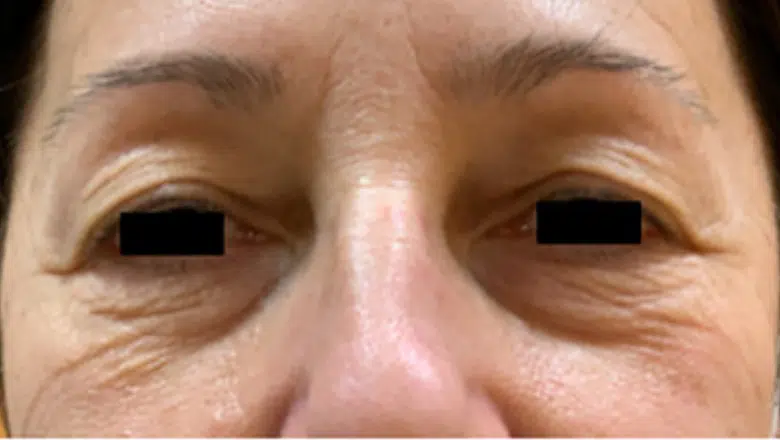
Blepharoplasty, or eyelid surgery, targets asymmetries in the upper or lower eyelids to achieve a balanced and rejuvenated eye appearance. This procedure involves the removal of excess skin and fat from the eyelids, followed by careful reshaping to eliminate sagging and restore a youthful, alert appearance to the eyes. Patients can anticipate taking a week off from work, with a full recovery expected within two weeks. Blepharoplasty not only enhances the aesthetic appeal of the eyes but also can improve the field of vision in cases where sagging eyelids obscure sight.
Brow lift
A brow lift is a surgical procedure aimed at lifting the eyebrows to a more aesthetically pleasing position. This not only elevates drooping eyelids but also contributes to a balanced and youthful appearance in the upper face. During the procedure, excess skin is removed, and the remaining skin is tightened and reshaped to achieve the desired eyebrow arch and position. The surgery typically requires 1-2 hours under general anaesthesia, with patients expecting a full recovery within two weeks. A browlift can dramatically enhance the facial expression, making it appear more open and rejuvenated.
Facelift Surgery for Facial Asymmetry
A facelift is a surgical procedure designed to create a more youthful and symmetrical appearance by tightening and smoothing the skin on your face. It can address asymmetries by harmonising the skin firmness and muscle tone on both sides of your face. The type of facelift you might require will depend on the specific areas of your face exhibiting asymmetry. Let’s discuss the different types of facelifts that target various parts of the face:
Upper Facelift (Brow Lift): This procedure specifically targets the area of your face above the eyes. A brow lift can rectify asymmetry in the eyebrows by adjusting the height of one eyebrow relative to the other to achieve a balanced look. Additionally, the removal of excess skin in the forehead area can help your eyes open more fully and evenly. As a bonus, smoothing out your forehead skin also lessens fine lines and wrinkles, resulting in a unified and refreshed appearance.
Mid-Facelift (Cheek Lift): This type of facelift is primarily focused on the middle portion of your face. By tightening the skin in this area, a mid-facelift can reduce the prominence of deep nasolabial folds (the lines that run from the nose to the corners of the mouth) and elevate sagging cheeks to a more balanced position. This results in a more proportional appearance in the middle section of your face, helping to rectify any asymmetry in your cheeks.
Lower Facelift: This procedure addresses sagging jowls and wrinkles around the chin which can contribute to facial asymmetry, particularly if one side of your face is sagging more than the other. During a lower facelift, your surgeon can redefine your jawline and smooth out the wrinkles on your chin, which significantly enhances the symmetry of your lower face, resulting in a more balanced overall appearance.
Full Facelift: If asymmetry is present in various areas of your face, including the forehead, cheeks, jaws, and neck, a full facelift might be the best solution. This comprehensive procedure rejuvenates the entire face by addressing and correcting asymmetries wherever they are present, resulting in a more unified and balanced facial appearance.
RELATED: Facelift Surgery FAQs – Q&A about Rhytidectomy
Neck Lift
The neck lift procedure is a transformative cosmetic surgery designed to refine the contours of the neck and jawline, thereby enhancing the symmetry and aesthetic appeal of the face. This procedure involves the meticulous removal of excess fat from the neck area. Following fat removal, the skin is carefully redressed and tightened, resulting in a more defined neck and jawline. The procedure typically spans 2-4 hours and may be performed in conjunction with other cosmetic surgeries, such as liposuction or a facelift, for a more comprehensive facial enhancement. Recovery from a necklift generally takes 6-8 weeks, during which patients see a significant improvement in their neck’s appearance.
Liposuction
Liposuction is a versatile surgical technique employed to eliminate unwanted fat deposits from specific areas of the body and face, such as the cheeks or jawline. This procedure is particularly effective in enhancing facial symmetry by addressing asymmetrical fat distribution. Liposuction involves a relatively quick surgical process, lasting between 1-1.5 hours, with one of the fastest recovery timelines of just one week. The result is a more sculpted, symmetrical facial appearance, contributing to an overall more harmonious look.
RELATED: Contouring Your Jawline With Chin Liposuction
Fat Transfer to the Face
Fat transfer to the face, also known as fat grafting, is another natural approach to addressing facial asymmetry. This method is particularly appealing to many as it doesn’t involve the use of any foreign substances.
During a facial fat transfer procedure, fat is extracted from another area of your body (commonly the stomach or buttocks) and then carefully injected into specific areas of your face. The strategic placement of these fat injections can be used to address facial imbalances by enhancing particular facial features, such as the chin, cheeks, or jaw. This helps to create a more symmetrical and harmonious facial appearance.
However, it’s worth noting that despite the numerous benefits of fat grafting, the transferred fat may shrink over time. Consequently, to achieve the desired facial volume and symmetry, more than one set of injections may be necessary.
RELATED: Micro & Nano Fat Grafting
Chin Reshaping Surgery
In the grand scheme of facial aesthetics, the chin holds a significant role. If your chin is too small or sticks out too much, it could throw off the overall balance of your face. Fortunately, chin reshaping surgery can address these issues and enhance facial proportions by modifying the appearance of the chin:
Chin Augmentation Surgery (Mentoplasty): In a chin augmentation procedure, your surgeon enhances a receding chin by inserting a chin implant or by shifting the chin bone forward. By doing this, the chin becomes more noticeable and aligns better with the rest of the face. This surgery can enhance the balance between your chin and nose, improving your overall facial aesthetics.
Chin Reduction Surgery: Alternatively, if your chin is overly prominent, it can be reduced in size through a chin reduction procedure. During this surgery, the surgeon will remove excess bone and then reshape the chin to achieve a more harmonious balance with the rest of your facial features. This surgery can greatly improve the overall symmetry of your face, leading to a more appealing aesthetic appearance.
Buccal Fat Removal
Buccal fat removal is a surgical procedure designed to reduce the size of your cheeks by eliminating fat from the inside. While having plump cheeks can indeed be charming, asymmetry – when one cheek is fuller than the other – can give the appearance of a face that’s overweight on one side. The outcome of this surgery tends to be long-lasting, more so than injectables or facial fat transfer, as the removed cheek fat doesn’t grow back.
During this chubby cheeks reduction operation, the surgeon will remove a small quantity of tissue and fat from the inside of one or both of your cheeks. It’s crucial for the surgeon to only remove the necessary amount of fat to ensure that your face preserves its natural symmetry and balanced proportions. The goal is to reduce the excess volume, yet maintain a harmonious look.
RELATED: Non-Surgical Alternatives to Buccal Fat Removal
Choosing the Best Treatment for Facial Asymmetry
Choosing the right treatment for facial asymmetry hinges on a variety of factors. These include your personal objectives, the specific cosmetic issues you’re dealing with, your age, the extent of your facial asymmetry, and any other aesthetic concerns you might have.
For some people, a facelift could be the solution to rectifying facial imbalance. For others, additional measures like fat grafting or the use of dermal fillers might be needed. In short, the appropriate treatment varies widely based on an individual’s circumstances.
Our specialist facial plastic surgeons will take the time to explain the various options for addressing facial asymmetry during a consultation at our clinic on Baker Street. They will provide comprehensive advice to help you select the treatment that best suits your needs.
Remember, the appeal of a face doesn’t solely rest on symmetry; it’s also about how all the facial elements harmoniously combine to create a unique and captivating look. Therefore, performing facial surgery requires more than mere surgical expertise. It’s about taking a holistic view of facial aesthetics.
Frequently Asked Questions About Facial Asymmetry Surgery
Can a facelift fix an asymmetrical face?
Yes, a facelift or a neck lift can considerably enhance facial symmetry. These procedures involve lifting different parts of your face to align them more symmetrically.
How long should I wait to see the results of surgical treatment for facial asymmetry?
The recovery period and the time it takes to see the outcome of surgical treatment for facial asymmetry vary based on the type and extent of the procedure undertaken. Generally, the final results can be noticeable within several weeks to several months. Here are some rough timelines for recovery from some common facial procedures:
- Rhinoplasty: You can generally expect to see results within 2 to 4 weeks.
- Blepharoplasty: You should notice results within a timeframe of 7 to 14 days.
- Facelift: It typically takes between 2 to 4 weeks to see the results.
- Neck Lift: The results can typically be seen between 2 to 6 weeks.
- Facial fat transfer: The results can usually be seen within 2 to 6 weeks.
- Otoplasty: Results can usually be seen within 4 to 6 weeks.
RELATED: Recovery after Cosmetic Surgery
Remember, these are just average time frames and the recovery process can differ for each individual. Always consult your facial plastic surgeon at Centre for Surgery for the most accurate information.
Enhancing Facial Harmony: Your Questions Answered
When considering facial aesthetics and the quest for symmetry, many individuals have questions about the nature of facial asymmetry, the quest for perfect symmetry, and the perceived attractiveness of symmetrical faces. Below, we delve into these queries in greater detail, providing insights and expert opinions to guide your understanding and decisions regarding cosmetic treatments.
Why does my face appear uneven?
Facial asymmetry is a common concern and can be attributed to a variety of factors, including genetics, environmental influences, and lifestyle habits. Such asymmetry might manifest in slight differences between the two sides of the face, whether in the eyes, nose, cheeks, or jawline. Consulting with a medical professional at Centre for Surgery can shed light on the specific causes of facial unevenness in your case. Our experts are well-versed in diagnosing the underlying reasons for asymmetry and can offer tailored treatment options to enhance facial balance and aesthetics. This personalised approach ensures that any interventions are closely aligned with your unique facial structure and aesthetic goals.
Is it possible to have a perfectly symmetrical face?
The notion of achieving perfect facial symmetry is a common aspiration, yet it is important to understand that absolute symmetry is exceedingly rare. Natural faces exhibit subtle imbalances that, more often than not, go unnoticed by the casual observer. The objective of cosmetic treatments is not to achieve flawless symmetry but rather to enhance facial harmony and balance. At Centre for Surgery, we emphasise the importance of realistic goals and expectations, focusing on improvements that accentuate your natural beauty while respecting the unique characteristics that make your face distinctive. This approach ensures outcomes that are both aesthetically pleasing and true to your individual identity.
Are symmetrical faces considered more attractive?
The relationship between facial symmetry and attractiveness has been the subject of various studies, with many suggesting that people tend to find symmetrical faces more appealing. However, it’s crucial to acknowledge that complete symmetry is a rarity, and minor asymmetries are a natural and normal part of human faces. These slight variances contribute to our individuality, giving each face its unique charm and character. Interestingly, research also indicates that minor asymmetries are often overlooked by others, implying that the quest for perfect symmetry might not significantly impact how attractive we are perceived by society. At Centre for Surgery, we believe in celebrating these individual differences, focusing on enhancing your natural beauty rather than conforming to an unattainable standard of perfection. Our goal is to help you feel confident and satisfied with your appearance, recognising that true attractiveness lies in the balance and harmony of features rather than in absolute symmetry.
Why Should You Choose Centre for Surgery for Your Facial Asymmetry Surgery?
Choosing to undergo facial asymmetry surgery is a significant decision, and it’s crucial that you’re in the best hands possible. At Centre for Surgery in London, we boast a team of highly qualified facial plastic surgeons who can perform a thorough evaluation of your unique situation, and devise the most appropriate treatment plan for you.
In our detailed consultations, our surgeons will spend time understanding your specific goals and expectations. We believe in having open and honest discussions about all aspects of the procedure, including any potential risks and the recovery timeline, to ensure you’re fully informed and comfortable before moving forward.
To schedule your initial consultation with one of our experts, please give us a call on 0207 993 4849. Our team is always ready and willing to assist you on your journey towards improved facial symmetry and enhanced confidence. We look forward to the opportunity of partnering with you in this transformative process.


